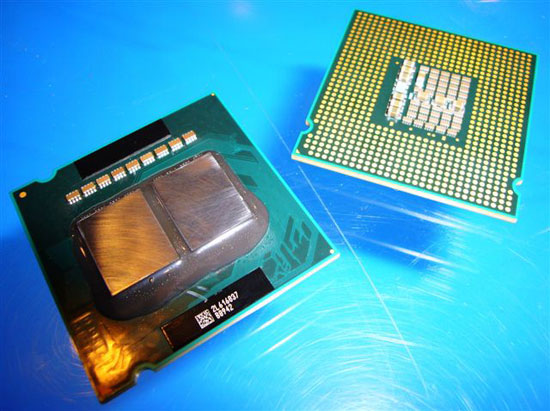Intel Core 2 Extreme QX6850 and Massive Price Cuts
by Anand Lal Shimpi on July 16, 2007 3:04 AM EST- Posted in
- CPUs
Do Four Cores Need a 1333MHz FSB?
AMD likes to call Intel's quad-core "fake" due to the fact that the chips themselves are composed of two independent dual-core die on a single package. Intel has used this multi-die package approach ever since the dual-core days in order to get CPUs to market quicker and do so at a lower cost. While Intel will eventually move to a single die quad-core design, its current designs are made up of two individual dual-core die.

The problem with Intel's approach is that all traffic from one pair of cores to the next has to go over the FSB, whereas AMD's quad-core Barcelona design places all four cores behind a shared L3 cache. With a single socket quad-core chip, FSB bandwidth is already at a premium given that four cores have to share the same amount of FSB bandwidth that two cores do in a dual-core system. In theory, Intel's quad-core CPUs could stand to benefit more from a 1333MHz FSB than their dual-core counterparts. You may remember from our review of the Core 2 Duo E6750 that the 1333MHz FSB only accounted for an average performance improvement of 1.9% over the 1066MHz FSB, but would things change with four cores running on the other end of that FSB?
To find out we compared the Core 2 Extreme QX6850 to the Core 2 Extreme QX6800, the former running at 3.0GHz on a 1333MHz FSB and the latter 2.93GHz/1066MHz. There is a 2.3% increase in clock speed that the QX6850 enjoys over the QX6800, but we can easily take that into account when looking at the margin of victory in our tests.
The chart below shows the performance increase the QX6850 sees over the QX6800 across our entire suite of benchmarks:

The faster FSB appears to do a little more with the quad-core QX6850 than we saw on the dual core E6750. The performance advantage is not tremendous, amounting to little more than low single-digit percentage point advantages across the board. Taking into account the ~2.2% increase in clock speed that accompanies the QX6850, an average of around a 2% increase in performance is what we'd attribute to the faster FSB.
By no means is it earth shattering or necessary for that point, at least not at these clock speeds. However, given the direction Intel is going in, if you're building a new system today you'll obviously want to opt for a 1333MHz FSB processor. Current quad-core owners shouldn't feel pressure to upgrade, the faster FSB does very little for performance.










68 Comments
View All Comments
gigahertz20 - Monday, July 16, 2007 - link
Ahhh man I loved the article but I was hoping for some overclocking benchmarks, very disappointing. I wanted to see an overclocked Q6600 vs. overclocked e6850, there were reports the E6850 can OC up to around 4GHz. I was hoping this article would show us some OC results. Is this planned for later or something?cpeter38 - Monday, July 16, 2007 - link
Another Ditto!!!!Sunrise089 - Monday, July 16, 2007 - link
and another!All the early Conroe reviews had OC numbers. And yes, by now we realize that as far as dual-cores go, any of the new parts should overclock about the same. It's really important to a lot of users however to know how the overclocking of these new parts matches up to the quad-core part.
Frumious1 - Monday, July 16, 2007 - link
You've got numbers http://www.anandtech.com/mb/showdoc.aspx?i=3020&am...">like this that have quad core hitting 3.60 GHz with appropriate cooling. Q6600 should easily hit 3.0-3.3 GHz with a reasonable HSF, and if you want something high-end like the Ultra-120 Extreme, maybe even 3.60 GHz (9x400). One more reason to go quad - just mind the energy bills!Sunrise089 - Monday, July 16, 2007 - link
yes, but what about if the dual-core part is overclocked to 4.0ghz?Frumious1 - Monday, July 16, 2007 - link
Given that overall performance goes to 2.4 GHz quad core over 3.0 GHz dual core (a 600 MHz difference), I can guarantee that a 3.6 GHz quad core would be better than 4.0 GHz dual core (a 400 MHz difference). That said, for gaming it really wouldn't matter much right now - no games even try to utilize more than two cores that I'm aware of. And don't even think about a 3.6 GHz overclocked quad core chip unless you have a beefy PSU!BikeDude - Tuesday, July 17, 2007 - link
Flight Simulator X SP1 adds multicore support and should benefit from additional (beyond dual) cores."As I stated previously, our multi-core support will take advantage of both 2 and 4 cores today, and more cores in the future when they become available."
(http://blogs.msdn.com/ptaylor/archive/2007/05/14/f...">http://blogs.msdn.com/ptaylor/archive/2007/05/14/f...
I am a bit disappointed that Anandtech doesn't bench FSX. I also miss the compiler benchmarks they used to do. AMD used to do quite well in those... (I say this as someone who uses compilers, not as a former AMD fanboy which I probably am)
RamarC - Monday, July 16, 2007 - link
anyone know what oc results i can expect with a p35-based mobo and a q6600? is 3.0ghz as easy to reach as it is with an e6600?ZDNetReader1 - Monday, July 16, 2007 - link
Ditto!! What he said!!MrKaz - Monday, July 16, 2007 - link
Price-wise, the only AMD/Intel competition we have here is between the FX-74 and the Q6700. Do keep in mind that as the FX-74 is a dual-socket configuration, the motherboard is a bit more expensive than what you can use with any of the single-socket quad-core Intel solutions.This is obviously true, but it’s also true that Intel motherboards for single socket VS AMD motherboards for single socket are also more expensive.
In my country equivalent ASUS AMD motherboard VS ASUS INTEL motherboard is around 30% to 50% cheaper.
Do keep that in mind too.